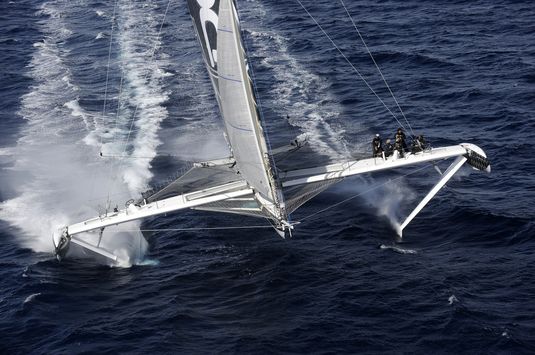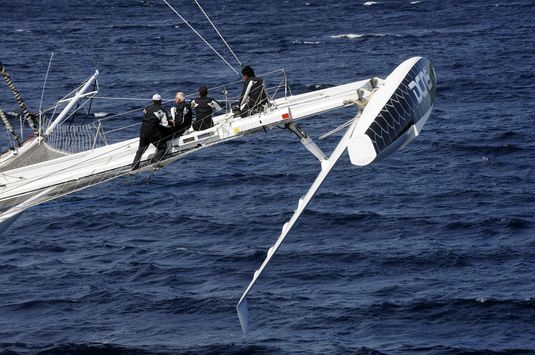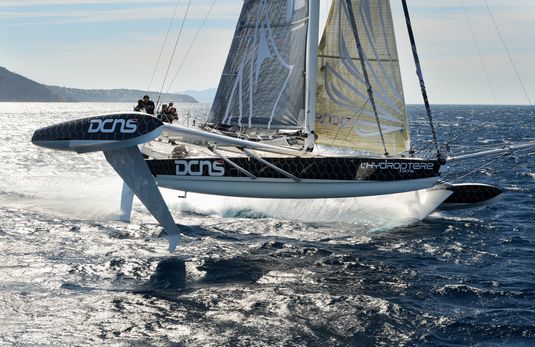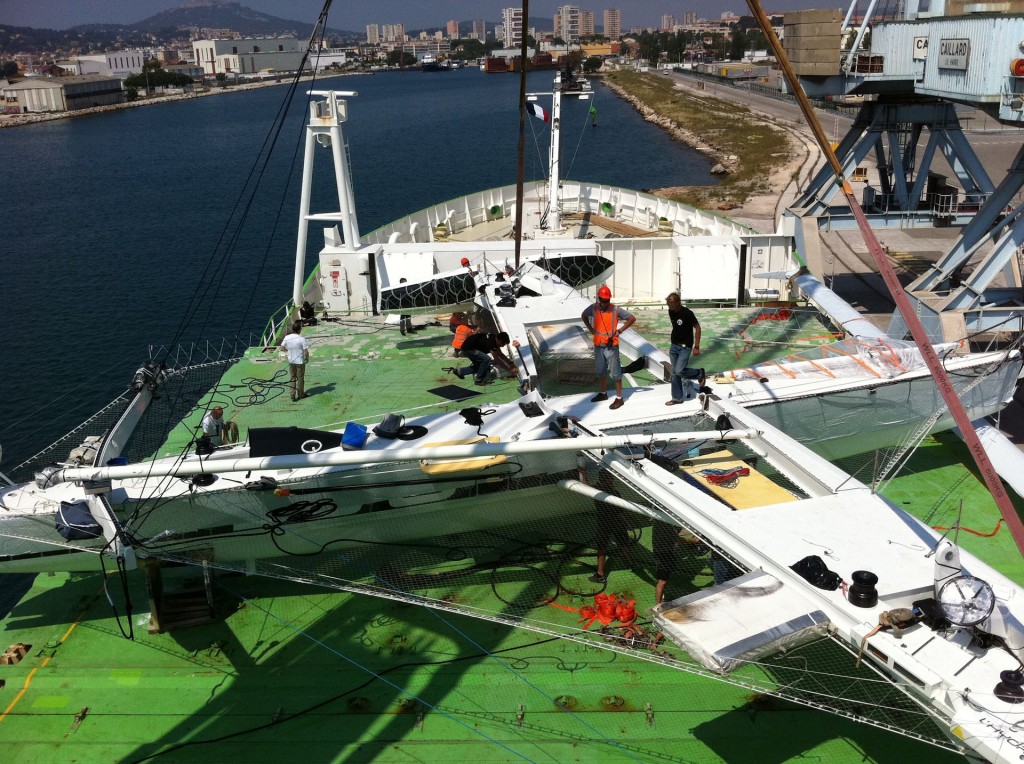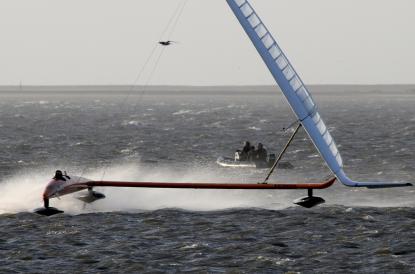Foiling Across an Ocean: It’s Time
“Five corsairs on a dream boat” is Alain Thébault’s description of himself and crew as they prepare for the first-ever transoceanic sailing record attempt on foils.
California-Hawaii.
Los Angeles-Honolulu.
Their 59-foot trimaran, L’Hydroptere DCNS, has never before been far from France, but this flagship of all foilers worldwide holds the absolute speed record over one nautical mile—50.17 knots, 57.7 mph—and for a time it took the 500 meter record away from the kites. There’s nothing else quite like it.
 At play in the Med Photo © Francis Demange
At play in the Med Photo © Francis Demange
The mojo: L’Hydroptere’s in-water foils are angled at 45 degrees, and they lift the boat when it reaches a speed of 10 knots. The hulls rise about 15 feet, and speeds can jump to 25 knots in 10 seconds or less . . .
The team’s engineers estimate the foils take more pressure than the wings of a jet fighter. Somewhere around 50 knots, the foils begin to cavitate, and the beast becomes, shall we say, temperamental . . .
 Thébault and his team have put in plenty of miles in the Med and the English Channel, but undertaking an open-ocean crossing of 2225 miles is unprecedented in the world of foil-born sailing craft. L’Hydroptere has been long in development, and if she proves up to the open ocean, she’s a threat and then some to the existing record of 4 days, 19 hours, 31 minutes held by Olivier de Kersauson and the maxi trimaran Geronimo. Can you say “determination”? The starting point was Thébault in 1985, abetted by Eric Tabarly, testing a foil-borne model in a pond at Versailles. In 1987 he sailed a one-third model, and in 1994 he launched the real deal. Then, for the next eleven years, it was a learning curve all the way. The headlines were all oopsies and almosts and Baby Fall Down Go Boom until the Channel crossing record of 2005 and, in 2008, the first outright speed record over 500 meters, 51.37 knots, raising the bar from kite sailor Alexandre Caizergue’s 50.26. In 2009, L’Hydroptere claimed the nautical mile record at 41.69 knots (video), raising windsurfer Björn Dunkerbeck’s previous mark of 41.14.
Thébault and his team have put in plenty of miles in the Med and the English Channel, but undertaking an open-ocean crossing of 2225 miles is unprecedented in the world of foil-born sailing craft. L’Hydroptere has been long in development, and if she proves up to the open ocean, she’s a threat and then some to the existing record of 4 days, 19 hours, 31 minutes held by Olivier de Kersauson and the maxi trimaran Geronimo. Can you say “determination”? The starting point was Thébault in 1985, abetted by Eric Tabarly, testing a foil-borne model in a pond at Versailles. In 1987 he sailed a one-third model, and in 1994 he launched the real deal. Then, for the next eleven years, it was a learning curve all the way. The headlines were all oopsies and almosts and Baby Fall Down Go Boom until the Channel crossing record of 2005 and, in 2008, the first outright speed record over 500 meters, 51.37 knots, raising the bar from kite sailor Alexandre Caizergue’s 50.26. In 2009, L’Hydroptere claimed the nautical mile record at 41.69 knots (video), raising windsurfer Björn Dunkerbeck’s previous mark of 41.14.
(Also in 2009, however, Caizergue and his kite reclaimed the 500 meter record. American Rob Douglas currently rules the roost at 55.65 knots.)
Now L’Hydroptere, with the nautical mile record again in hand at 50.17 knots, moves on to the open ocean. The challenge and adventure go beyond what most sailors can imagine, even those of us who have sailed Los Angeles-Honolulu a few times and thought we were going fast.
With what could be regarded as understatement, Thébault says, “l’Hydroptère DCNS is a very nervous craft. Every detail is important. On board, we operate as a team of mountaineers; everyone is responsible for each other; trust must be total.” If ever one were going to choose companions for combat sailing, this would be the time, and Thébault has surrounded himself with a can-do team: Yves Parlier, Jean Le Cam, Luc Alphand and Jacques Vincent. Parlier is a tough-as-nails circumnavigator, a legend in his own right, a past crewmate of Eric Tabarly and a veteran of a Channel crossing in L’Hydroptere in nine-foot waves. Alphand was a major downhill skiier, retired by injuries, who went on to win the Paris-Dakar auto rally. Now he drives L’hydroptere. Vincent has made eight circumnavigations and 28 transatlantics. You get the idea.
The boat was modified for this effort over a period of months and then tested in the Med, first in light conditions, and then in the windiest stuff available, where boatspeed peaked at 45 knots and for a time stabilized at 30. It’s downwind in the sense that you end up downwind of where you started, but the apparent wind is always up your nose.
The challenge will be completely different from a round-the-world record attempt, which crosses the doldrums of the equator twice. The round-the-world attempt, to have a shot at success, must capture and ride the advance of two sequential storm systems in the miles between entering and exiting the Southern Ocean; above all, there is the matter of surviving the Southern Ocean. For L’Hydroptere, navigating the summertime route from the US mainland to Hawaii is about riding the tradewinds while skirting the Pacific High Pressure Zone.
L’Hydroptere was loaded onto a cargo ship last week in Toulon, bound for Angel’s Gate, the entry to the Port of Los Angeles. Transpac Yacht Club Commodore Dave Cort reports an expected arrival of June 24. There will be more trial sailing in Southern California waters, and a wait for the right window to open as the Pacific High Pressure Zone builds a tradewind highway to Hawaii. At its best, this is the ultimate ocean crossing, ending in a subtropical rush of blue on blue as first Koko Head and then Diamond Head rise above the roller-coaster-ready Molokai Channel.
Tech-heads have been playing with foils for decades and getting incredible speeds out of them. As reader Tom Speer notes in a comment below, “L’Hydroptere will not be the first hydrofoil to sail to Hawaii. That honor belongs to Dave Keiper’s Williwaw, a 32 ft plywood trimaran built in Sausalito. He sailed it from San Francisco to Hawaii and from Hawaii to the south seas islands in the 1970’s. Keiper’s account of the trip can be found in his book, Hydrofoil Voyager, available at foils.org.
In the 1990’s, the stock Hobie TriFoiler could hit 30 knots, making it the fastest production boat of its day, or still . . .
More recently, foil-borne has made the crossover to monohull dinghies, Moths in particular, and they are a giggle and a half to watch, scooting past their water-borne brethren . . .
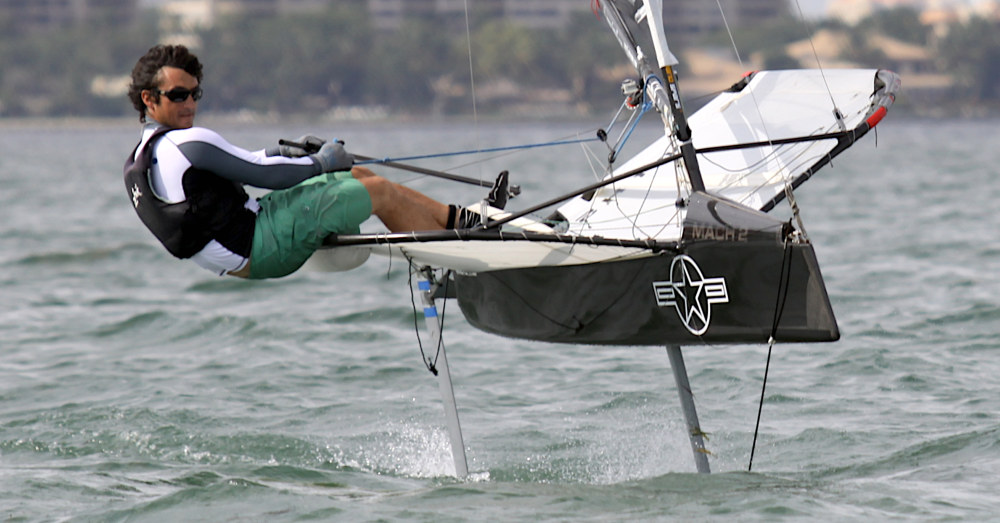 Speed demon hero Bora Gulari. Photo © Meredith Block
Speed demon hero Bora Gulari. Photo © Meredith Block
and to kiteboards, where they jump like champions, but have yet to prove superior on all points of sail . . .
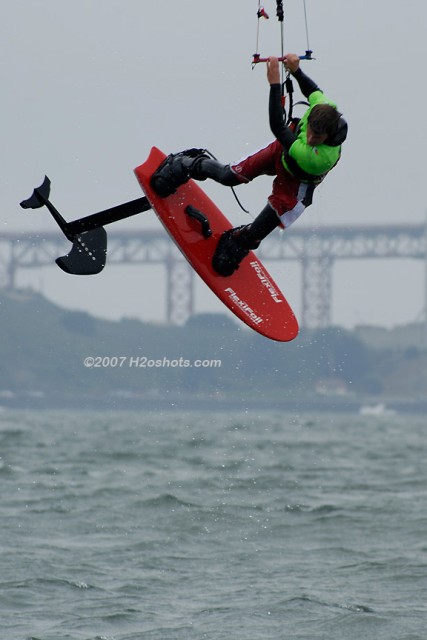 > Photo © Erik Simonson
> Photo © Erik Simonson
It’s old news, but still fascinating to me, that foil-borne kiteboards in international competition proved almost unbeatable in racing upwind, but downwind they were so slick that riders could not exert enough resistance to their kites to carve those big loops that build extra apparent wind—and speed. The trade-off didn’t work. What they gained upwind, they lost downwind. L’Hydroptere does not loop its sails, so that is not an issue. Less resistance is less resistance is more speed.
L’Hydroptere’s sponsor, DCNS, is an international naval and energy group. By my dirty math, a “mere” 19.5 knot average would squeak out a new Los Angeles-Honolulu record for L’Hydroptere DNCS. It’s doable to the point of looking like almost-easy pickings. Unless something goes wrong. There’s more at the team’s English-friendly (at last) web site, which includes this time line video of development from model to Pacific-ready.
For long term stick-to-it-iveness there’s also Paul Larsen and Sailrocket, still tilting at a 500-meter record with a unique design that keeps uncovering new noogies of difficulty (“The ‘T’ foil is officially dead. The ‘strut’ was just too draggy”) in the upper ranges of speed.
The web site’s gallery includes a shot of a high-flying flip at 52 knots, if that might help you understand. And this overview from Paul: “There have been high speed hydrofoils before that have gone way over 50 or even 60 knots. But they have all been powered. The difference is that their foils have to lift the static weight of the craft but do not have to oppose the side forces generated by the sails. It’s a fascinating puzzle.”
And then there’s this. Stephen Bourn reports that he is swallowed by work and PhD studies, but hopes to get back to work soon on WBHF. Yet another dream, eh what?

